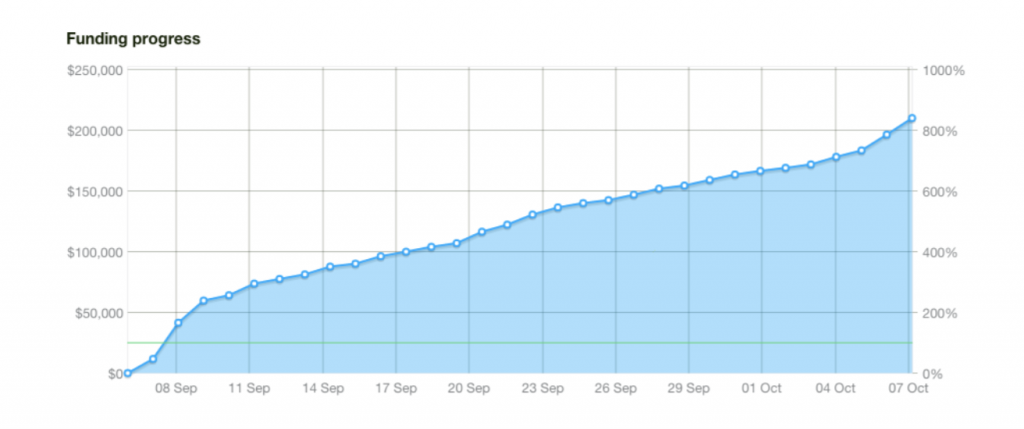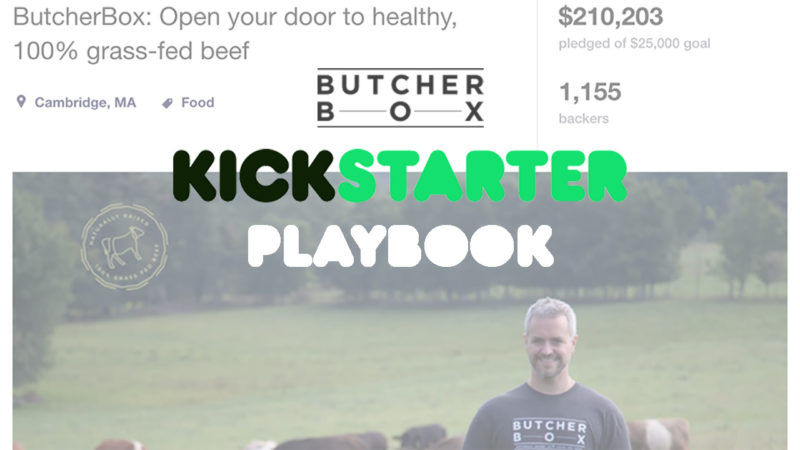Last Updated on January 16, 2024
When we launched our Kickstarter campaign in 2015, we created a shareable document that we thought would be a good repository for the things we were learning in the run-up to, launch, and conclusion of our campaign.
It was a brain dump of the most valuable things we learned. But it also started as something else, since the beginning of ButcherBox we thought about potentially launching another product or service through Kickstarter at some point. So we wanted to make sure we remembered the nuggets of insight we picked up through the process.
It is fascinating, looking back, how much we learned and how much of a science a Kickstarter campaign can be. Campaigns are really fun and challenging. It is a sprint for 30 days.
We had no idea what the demand might be for grass-fed meat, and the market ended up being very receptive. Kickstarter confirmed for us that ButcherBox was not only a good idea but that we had the right timing to launch.
Kickstarter is a great way to take the temperature of any potential market for almost any business idea.
Once we blew by our initial goal of $25,000 — in 24 hours — and ended up raising more than $210,000 in the campaign, we had a bunch of contacts start reaching out to us for advice and wanting to talk about what worked.
So we shared our ButcherBox Kickstarter Playbook with them, and we are sharing it with you too.
Check it out.
The ButcherBox Kickstarter Playbook

by Mike Salguero and Mike Filbey
GENERAL ADVICE
- The presentation matters. That means all the copy, photos, the video, basically anything visual. We invested heavily in branding and design and were meticulous with the copy. We looked at the length of other successful campaigns in terms of word count and pictures, and we tried to mimic their length and style.
- Set your fundraising goal low. Our goal on the campaign was $25,000. But internally, we had a goal-reaching $100,000. We discovered that hitting your goal on Day 1 or Day 2 may result in you becoming a “Project We Love’ and you’ll get featured on Kickstarter both on the homepage and the “Project We Love” section. Also, perception is the reality, so being able to say that you’re 250% funded, for example, after only one week will get people’s attention — including the press. This reality, of course, depends solely on the number you set as your initial fundraising goal. While you are at it, you can put in one or two large dollar amount prizes as a way of asking really close family and friends to back you and help you cross the line early!

- Lay some groundwork before launch. We’d estimate that 30% of the selling occurs before you even launch. You must pre-sell the shit out of your product and campaign. Before we launched, we had soft commitments from friends and family to get us to about $20,000 of the $25K we knew we needed. We got that and more in a day after launching.
- Running a campaign is pretty much a full-time job. You must be ready and make sure you’re hyper-responsive to people’s comments and questions.
- Take care of early-adopters, they are a key to generating buzz. You should create at least one ‘Early Bird Reward’ that gives people a discount if they’re one of the first 100-200 backers. Also, leverage those early-adopters by doing giveaways at certain thresholds. We had a “stretch” goal that if we hit $150,000 everyone would receive free bacon in their first box. When we had raised $145K, those who had already backed us were foaming at the mouth trying to sell us to their friends.
- Do some media research. You might want to see what writers and news outlets often cover interesting Kickstarter campaigns. Although this happens less these days, we received plenty of coverage because of the early success (manufactured somewhat by setting a low target) of the campaign. If they’ve done Kickstarter coverage in the past, there’s a good chance they’d write about you too.
- Have social media accounts ready before the campaign. Create Facebook, Twitter, and Instagram accounts if you don’t already have them. More than that, start populating and growing them ASAP. This will serve as a great way that you can market the Kickstarter and all the “news” related to it to a wider audience once your campaign goes live. We did small tests with ad creative for a few weeks before we launched the actual project. Those ad creatives went to a landing page where we collected emails that we eventually used for promotions about our Kickstarter campaign.
- Don’t be afraid to seek out what has worked in the past. Go to Kickstarter.com and look at what were the most funded projects in your space (e.g. food). Enventys Partners is a marketing service provider that can help you run a successful campaign as well.
- Leverage social media ads. You can run paid advertisements via Facebook to drive targeted traffic to your Kickstarter page. However, we only did this for the first ten or so days and then stopped because they weren’t super effective. You may be better at targeting or more successful at this than we were.
- Use all of your assets. If you already have a website then use it to direct people to your Kickstarter funding page (make this the key or “hero” image on your homepage). You can also use your website homepage before you launch to collect email addresses telling people they’ll get notified as soon as your campaign goes live. This could be very attractive for early adopters wanting to be part of the “early bird offers.”
IMPORTANT TACTICS
Here are a few things to do in the lead-up and during the campaign.
Press: Try to line up press stories to hit once your Kickstarter campaign goes live. This could take a while so plan for 4 – 8 weeks of lead time.
Video: This is vital. Make sure to create a killer video of the product and the founding team. We worked with someone who did this for us, and it was excellent. You can watch it below:
Images: Also, use a professional for the photos of your product. Use a bunch of different images on your campaign page.
Copy: Take at least two weeks to write copy and design the layout for the campaign page.
Your eyes aren’t enough; make sure to send it around to friends and family for feedback.
Email: A few weeks before launch, send a personal email to a few dozen folks who you think will support you and get them to informally agree to make a purchase the day your campaign goes live. Use LinkedIn and other contacts lists to compile email addresses and then send an email announcing your campaign and asking for your support once it goes live. Both Mike and I sent four different emails to our LinkedIn contacts throughout the course of the campaign. These were filled with updates on the status of the project and a call to action for them to back us and share our link with their friends via social media or email.
Update and Cross-Promote: Do a ‘backer update’ email via Kickstarter at least once a week. We averaged two to three per week. You can see examples of these updates here. Within these updates you must do co-promotions, meaning you promote other projects on Kickstarter (up to three within an update). In turn, those other projects promote you in their backer updates.
You want to find campaigns that mirror your own. That means that they should have at least as many backers as you have and are in a somewhat similar category. Be selective with who you ask to do a co-promotion. If you do an update without a co-promo, it is a missed opportunity. Reach out to about seven or eight other project owners at the start of each week to be sure you get at least three to five who agree to a co-promotion.
Stretch: You will need to have ‘stretch’ fundraising goals. This enables you to gain buy-in from your backers and give them an incentive to share your campaign. For example, we had a $150,000 stretch goal where we’d add free bacon to every box, and people went nuts for it. (As a bonus, this cost us very little to add.)
Influencers: Identify influencers in your space and start building relationships with them. Kickstarter is a great excuse to reach out to them and ask for support or get them excited about your mission. Maybe send them free product, ask for social shares, and try to get featured in a blog post or email newsletter they are associated with. You can also see if they are willing to do giveaways with their fans. This is a great way to get exposure and get them to write about you. Getting in an email newsletter of a key influencer can be gold.
Maximize One Social Channel: It’s great to have a presence on multiple social media platforms but choose one that you think will have the best ROI and start building up your audience there. Once you launch on Kickstarter, this will be the tribe that will support you. We did Facebook ads to get likes, and it worked well.
ONCE YOUR CAMPAIGN IS FINISHED (AND FUNDED)
Data Collection: Read this article carfeully! This is a guide for collecting info from backers at end of campaign. You only have one chance to collect info from backers so don’t mess it up!
Stay in Contact: Continue to send backer updates often, keeping your backers posted on your progress and shipping progress.
Mike Filbey co-founded ButcherBox and Canary. He was also Head of Marketing at ButcherBox



